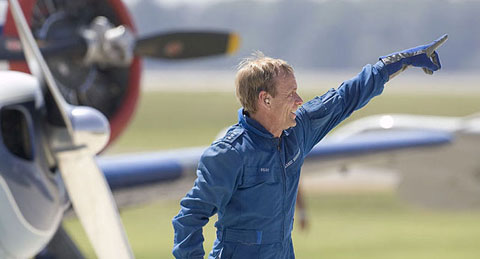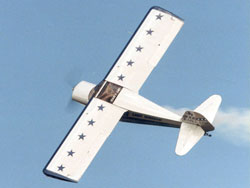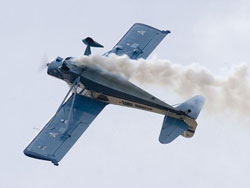
Photos used with the permission of Randy Henderson.
Shutting down the engine of his highly modified experimental 1946 clipped-wing Taylorcraft Texas T-Cart at 5,000 feet agl, airshow performer Randy Henderson completes a three- to four-minute series of aerobatic maneuvers—loops, rolls, or hammerhead—before landing (engine still off) in front of a crowd of spectators.
“The average person can’t relate to flying an Extra, but there is a chance they could go out and get a Taylorcraft,” Henderson said of the importance of connecting with his audience and choice of aircraft. “It plants in their mind, ‘Hey, I could do that.’”
Now, he wants his routine and his personal story to inspire spectators to say, “Hey, I could do that,” to a much tougher challenge—beating cancer.
Henderson, a 32-year Southwest Airlines pilot and 30-year airshow performer, was diagnosed with prostate cancer in January 2006. The prostate was removed laparoscopically in May 2007; he had a second surgery after that but did not need chemotherapy or radiation. In total, the Frisco, Texas-based aviation veteran who performed in airshows while maintaining a regular flying schedule at Southwest was grounded for a year and a half. Not an easy task for someone who jokes that he flies “four days right side up, three days upside down.” He celebrated his return to the airshow circuit after cancer at Sun ’n Fun this year.
“You have a tendency to not want to talk about cancer,” Henderson said, explaining that he didn’t want to “carry the cancer message” after his personal battle until he saw how many people are affected by the disease and need hope.
 According to the American Cancer Society, “half of all men and one-third of all women in the U.S. will develop cancer during their lifetimes.” More than 217,000 new cases of prostate cancer were diagnosed in 2010, according to the group, and is the “second leading cause of cancer death in men, behind only lung cancer.”
According to the American Cancer Society, “half of all men and one-third of all women in the U.S. will develop cancer during their lifetimes.” More than 217,000 new cases of prostate cancer were diagnosed in 2010, according to the group, and is the “second leading cause of cancer death in men, behind only lung cancer.”
Challenge of a lifetime
Henderson was used to challenges, and he thrived on them. Working for a cargo company in the late 1970s, Henderson flew DC-3s. On his first night as captain of a DC-3, he experienced two engine failures. He called it quits for the night, telling the cargo company “that’s all the adrenaline this little body has in it.”
Once he had to talk two passengers back onto a Southwest jet after they refused to fly with such a young captain (Henderson was 31 at the time). He successfully convinced one to come back onboard.
In the early 1980s, he dedicated two years at 40 hours a week of spare time to build his modified Taylorcraft with a friend. In 1998, Henderson took top prize in the intermediate category of the International Aerobatic Club’s National Championship.
But this challenge was different.
“Everything in my life changed,” he said, the pain of that time period still evident in his Texas drawl. “I thought it was all gone.”

Not only was he grounded from his profession and hobby, facing a disease that sends fear through anyone whose life has been touched by it, but the aviation industry was moving on, seemingly without him. The airlines switched to autothrottles while he was grounded, which would require new training.
“It was a challenge,” he said. The key is to have a support group. “It takes a lot of propping up to keep going,” he added.
‘Whatever it takes’
Henderson’s crew chief Dan Hite was key in boosting his spirits. “I just have been around people who have gone through similar things, and [I was] fortunate enough to be in the position to be of assistance,” said Hite, who stuck by Henderson every step of the way. Hite maintains the aircraft and helps ferry it from show to show when Henderson is unable because of conflicts with his Southwest work schedule.

Cancer free, with first class medical certificate in hand, Henderson returned to Southwest, unsure of what to expect. His return to the captain’s seat at Southwest took the support of fellow coworkers.
 “Whatever it takes, we’re gonna get this done,” Henderson recalled the airline’s director of training telling him. He completed an intensive one-on-one six-week training program to get up to speed on the changes that had taken place while he was grounded.
“Whatever it takes, we’re gonna get this done,” Henderson recalled the airline’s director of training telling him. He completed an intensive one-on-one six-week training program to get up to speed on the changes that had taken place while he was grounded.
Whether he’s flying right side up in a Southwest airliner or upside down in his T-Cart, Henderson says he’s “living proof that anyone can do it.”



